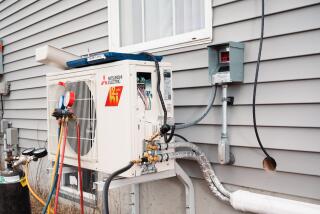Mechanical Engineer Puts Home to Solar Power Test
- Share via
GOLDEN, Colo. — Otto Van Geet’s 3,000-square-foot mountain home not only has a spectacular view of Pike’s Peak, it comes without an electric bill.
More than a mile from the nearest power grid, a 1,200-watt solar system powers lights and runs the television, the computer and the stereo. Lots of wide, specially glazed windows allow sunlight to brighten the two-story home but keep too much heat from seeping in--no air-conditioning needed.
Thick, concrete “Trombe” walls function as large thermal storage batteries in the chilly air at 9,300 feet above sea level, trapping heat and channeling it inside.
Van Geet, a mechanical engineer at the U.S. Energy Department’s National Renewable Energy Laboratory, said his home, about 20 miles west of Golden, is a testament to alternative energy in a nation suffering its worst energy crisis in more than a quarter of a century.
Using technology being developed at the lab, Van Geet spent his own money to build a house that uses 75% less energy than a standard home but sacrifices none of the comfort.
“We wanted to live in view of the Continental Divide,” he said. “Because it’s off the electric grid, it made the land much more affordable and it made sense to apply the things we talk about [at NREL].”
Van Geet used fluorescent lighting, which is about three to four times more efficient than incandescent lighting, the most common but most inefficient source of light. High-efficiency appliances like Van Geet’s refrigerator also reduce energy use.
“The goal of the house, since no power supply is available, is to minimize energy use,” Van Geet said. “Then you start to meet the remaining uses with renewable sources.”
The home, with vaulted ceilings and a loft, is positioned to best take advantage of abundant alpine sunlight. “It’s a cold climate with a lot of sun, so we’re basically putting the sun to work,” he said.
Solar energy, from panels mounted beside the home, provides more than 90% of the electricity. The rest comes from a propane-fired generator, which kicks in if there are several cloudy days in a row.
Propane cost Van Geet $100 last year, the only money he spent on power.
“Every house built today could easily use 50% less energy by being designed smart, and if you’re aggressive more than that,” he said.
At around $200,000, the house cost more to build than a standard one, but for Van Geet and his wife Kelly, the cost was offset by the savings on the land and electricity bills. They also saved about $100,000 by not extending power lines to their land.
The only drawbacks are that the system requires slightly more maintenance than grid power, he said. Water has to be added to the batteries that store energy from the solar panels a few times a year, and those batteries have to be replaced every five to 10 years.
*
On the Net:
Van Geet home views:
https://www.nrel.gov/buildings/high
performance/projects/vangeet/
pictures.htm
More to Read
Inside the business of entertainment
The Wide Shot brings you news, analysis and insights on everything from streaming wars to production — and what it all means for the future.
You may occasionally receive promotional content from the Los Angeles Times.








